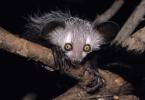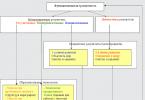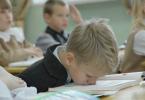Test on the creativity of V.V. Mayakovsky
1. What literary movement of the early 20th century did V. Mayakovsky consider himself to be:
1) symbolism 2) acmeism 3) futurism
2. Tag topics early lyrics Mayakovsky.
1) denunciation of the petty-bourgeois, philistine world 2) rejection of the war of 1914 3) the loneliness of the poet in the world of people 4) building socialism 5) the Leninist theme
3. By what principle are these poems united: “About rubbish”, “Seated”
1) about the purpose of poetry 2) satirical 3) pre-October lyrics 4) love lyrics
4. From which poem are these lines:
Marx looked from the wall, looked...
And suddenly
opened his mouth
Yes, how to scream:
"Threaded the revolution of the narrow-minded people."
1) "Sat" 2) "To you!" 3) "About rubbish" 4) "Anniversary"
5. What became for Mayakovsky the most striking subject of denunciation:
1) political enemies of the revolution 2) external enemies of the revolution 3) philistinism and bureaucracy 4) religion and the church
6. What poem is not about love?
1) "Lily!" 2) "Letter to Tatyana Yakovleva" 3) "Listen!"
7. What is not typical for Mayakovsky's poetry?
8. Where was Mayakovsky born?
1) in the Oryol region 2) in Georgia 3) in Moscow 4) in Taganrog
9. In what year did Mayakovsky die?
1) in 1925 2) in 1929 3) in 1930 4) in 1935
10. Which of the works of V. Mayakovsky expresses the idea of denunciation of petty-bourgeois life?
a) "About rubbish"; b) "Passed"; c) "Bath"; d) Listen!
11. What genre do the works "Bedbug", "Bath", "Mystery-buff" belong to?
a) a lyric poem b) a poem; c) ode; d) play.
12. Name stylistic device, used by Mayakovsky in the following lines:“... I hate / all kinds of carrion! // I love / all life!”.
13. Name the means of artistic representation used by Mayakovsky in the following fragment:"Mother! / Your son is beautifully ill!”.
14. Name the means of artistic representation used by Mayakovsky in the following fragment:“All of you on the butterfly of a poetic heart / perch, dirty, in galoshes and without galoshes ...”.
15. In what work did V.V. Mayakovsky sums up his work?
a) "Flute-spine"; b) "Vladimir Mayakovsky"; c) "I myself"; d) out loud.
16. The city in which the action of the play "The Bedbug" by V.V. takes place. Mayakovsky
a) Tula, b) Tabov, c) Moscow, d) Lipetsk
17. Femme fatale in the life of Mayakovsky
A) Tatyana Yakovleva B) Veronika Polonskaya C) Lilia Brik
18. To shock the public, according to V.V. Mayakovsky, then
A) to please B) to shock C) to agitate
19. Mayakovsky's pre-revolutionary satire
A) "About rubbish" B) "Hymn to dinner" C) "Happy sitting"
20. Which of the following characters are actors plays by V. Mayakovsky "The Bedbug"?
a) Prisypkin, b) Elsevira Renaissance, c) Chudakov, d) Oleg Bonn
21. In what year was Prisypkin, the hero from the comedy "Klop", thawed?
a) 2030, b) 1979, c) 1960, d) 2006
22. What is Mayakovsky's contribution to art? (give a detailed answer)
Option 1
Match the years of life and the names of poets.
Match the facts of the biography and the names of the poets.
Match the characteristics-aphorisms and the names of poets.
Match the features of the expressive system and the names of poets.
Match the attitude to the revolution and the names of the poets.
Match the literary movement and the names of the poets.
Match funds artistic expressiveness:
8. Determine artistic means expressiveness, with the help of which S. Yesenin creates an image of nature:
White birch
under my window
covered with snow,
Exactly silver.
A) epithets;
B) metaphor;
Comparing to;
D) metaphorical comparison
I'll be back when the branches spread
In spring our white garden,
Only you me already at dawn
Don't wake up like many years ago.
A) A.A. Fet;
B) A.S. Pushkin;
C) S.A. Yesenin;
D) A.A. Block.
10. Which of Mayakovsky's friends discovered a poetic gift in him, calling him a "genius poet"?
a). D.D. Burliuk;
b).V.V. Kamensky;
c) V. Khlebnikov;
d).A. Twisted;
11 . By characteristics identify modernist trends in literature:
1) A direction that denied the artistic and moral heritage, preaching the destruction of the forms and conventions of art for the sake of merging it with an accelerated life process.
2) A direction that considered the goal of art to be an intuitive comprehension of world unity; art was seen as the unifying principle of such unity. Characterized by "secret writing of the inexpressible", understatement, replacement of the image.
3) The direction that proclaimed the "intrinsic value" of the phenomena of life, the cult of art as a skill; rejection of the mystical nebula; creating a visible, concrete image.
12. Which of the poets does not belong to Silver Age?
1) K. Balmont
3) N. Gumilyov
4) V. Bryusov
13. What literary trend were the following poets close to: Akhmatova, Gumilyov, Gorodetsky, Mandelstam?
1) symbolism
2) acmeism
3) futurism
14. Modernist trend, asserting individualism, subjectivism. The main principles of aesthetics are "art for art's sake", understatement, replacement of the image:
1) symbolism
2) acmeism
3) futurism
1) D. Burliuk, V. Kamensky, V. Khlebnikov, V. Mayakovsky.
2) N. Gumilyov, A. Akhmatova, O. Mandelstam.
3) V. Bryusov, D. Merezhkovsky, A. Blok, K. Balmont, A. Bely.
16. Fix the bug: symbolism is a symbol, acmeism is beauty, futurism is the future
Option 2
1. Match the facts of the biography and the names of the poets.
2. Match the portraits and names of poets.
Match the key images and names of poets.
Match the key images of the Motherland and the names of poets.
Match works and names.
Match the literary current of the beginning XX century with "key" words:
7. C. Yesenin used an artistic technique - antithesis - in his appeal to the theme of the Motherland. Antithesis is:
A) an artistic technique that consists in using a transparent allusion to some well-known everyday, literary or historical fact instead of mentioning the fact itself;
B) artistic opposition of character, circumstances, concepts, images, etc., creating the effect of sharp contrast;
C) the reception of sound recording, which consists in repeating consonants that are identical or close in sound.
8. About which of his poems V.V. Mayakovsky said: "Four cries of four parts".
A) "Cloud in pants";
B) "Left march";
C) “V.I. Lenin";
D) Good!
9. Name Yesenin's poem, which is his kind of testament:
A) “Flowers say to me: goodbye ..”
B) "Soviet Russia";
C) "Goodbye, my friend, goodbye";
D) "The golden grove dissuaded ..."
Oh, spring without end and without edge-
Endless and endless dream!
I recognize you, life! I accept!
And I greet with the sound of the shield!
A) A.A. Fet;
B) A.S. Pushkin;
C) S.A. Yesenin;
D) A.A. Block.
11. By characteristic features, determine the modernist trends in literature:
1) A direction that considered the goal of art to be an intuitive comprehension of world unity; art was seen as the unifying principle of such unity. Characterized by "secret writing of the inexpressible", understatement, replacement of the image.
2) The direction that proclaimed the "intrinsic value" of the phenomena of life, the cult of art as a skill; rejection of the mystical nebula; creating a visible, concrete image.
3) A direction that denied the artistic and moral heritage, preaching the destruction of the forms and conventions of art for the sake of merging it with an accelerated life process.
12. Which of the modernist trends in Russia appeared first?
1) FUTURISM
2) ACMEISM
3) SYMBOLISM
4) MODERNISM
13. Which of the poets does not belong to the Silver Age of Russian poetry?
1) B. Pasternak
2) V. Khlebnikov
3) K. Balmont
14. What literary trend were the following poets close to: Merezhkovsky, Gippius, Balmont, Bryusov, Blok, Bely?
1) symbolism
2) acmeism
3) futurism
15. What direction did the poets belong to:
1) V. Bryusov, D. Merezhkovsky, A. Blok, K. Balmont, A. Bely.
2) D. Burliuk, V. Kamensky, V. Khlebnikov, V. Mayakovsky.
3) N. Gumilyov, A. Akhmatova, O. Mandelstam.
16. Fix the bug: symbolism - a symbol, acmeism - the future, futurism - flourishing
1. What is the innovation of the poetry of V. Mayakovsky?
a. Accent-tonic verse
b. Use of the grotesque
in. Expressive neologisms
d. Folklore images
2. What makes it different lyrical hero early poetry of V. Mayakovsky?
a. Optimism
b. Loneliness
in. theomachism
d. Social rebellion
3. What poetic trend was the early V. Mayakovsky close to?
a. Imagism
b. Symbolism
in. Acmeism
d. Futurism
4. What works of V. Mayakovsky reveal the theme of love?
a. "Flute-Spine"
b. "Nate!"
in. "A cloud in pants"
Mr. "Good!"
5. What works of V. Mayakovsky have a satirical orientation?
a. "Hymn to the scientist"
b. "Listen!"
in. "Happy"
Mr. "About it"
e. "War and Peace"
6. What is the main technique used by V. Mayakovsky in the poem "Seated"?
a. personification
b. Antithesis
in. Grotesque
d. Metaphor
7. What biblical legend underlies the plot of V. Mayakovsky's Mystery Buff?
a. About Cain and Abel
b. About the global flood
in. About the Tower of Babel
8. From what verses is the poetic motto of V. Mayakovsky taken
Shine always, shine everywhere, until the last days of the bottom, shine - and no nails! Here is my slogan - And the sun!
a. "About it"
b. " Extraordinary Adventure, who was with Vladimir Mayakovsky in the summer at the dacha "
in. "150,000,000"
9. In which comedy by V. Mayakovsky is satire directed against bureaucracy?
a. "Bug"
b. "Mystery Buff"
in. "Bath"
10. Which of the following characters are the characters in V. Mayakovsky's play "The Bedbug"?
a. Prisypkin
b. Elsevier Renaissance
in. Chudakov
Oleg Bonn material from the site
11. In what verses did V. Mayakovsky ridicule philistinism?
a. "Happy"
b. "Sneaky"
in. "Oh rubbish"
city "Khanzha"
Right answers:
1. a, c
2. b, c
4. a, c
5. a, c
Test
Exercise 1
What literary movement of the early 20th century did V. Mayakovsky consider himself to be:
1. Symbolism
2. Acmeism
3. Cubofuturism
4. Egofuturism
Task 2
1. What, according to Mayakovsky, is the power of lyrics:
2. Charged with a big feeling, a big idea
3. In descriptiveness, in reflection of life reality
4. In philosophical content, "the study of the soul."
Task 3
Which of the statements is more consistent with the tasks of art according to Mayakovsky:
1. "Art for art's sake"
2. "Art and politics are incompatible"
3. “We need to shatter the fairy tale about the apoliticality of art”
4. "Art is several steps ahead of its time"
Task 4
Of which of his poems did he say:
1. "Four Shouts of Four Parts"
2. "Cloud in pants"
3. "Left march"
5. "Good!"
Task 5
often uses the grotesque in his poetry. Grotesque is:
1. An artistic technique of intentionally distorting something, a bizarre combination of the fantastic with the lifelike.
2. One of the tropes, artistic exaggeration
3. One of the types of comic, caustic, angry, mocking mockery
Task 6
Poem. Loudly declaring the birth of the poetry of the revolution was a poem by V. Mayakovsky:
1. "Left march"
2. "Protsessed"
3. "Anniversary"
Task 7
What became for V. Mayakovsky the most striking subject of denunciation:
2. Political enemies of the revolution
3. External enemies of the Soviet Republic
4. Religion and Church
Task 8
On the appointment of the poet and poetry, V. Mayakovsky said:
1. In the poem "Letter to Tatyana Yakovleva"
3. In the poem "The Sitting Ones"
4. In the poem "To Comrade Netta - the ship and the man"
Vladimir Mayakovsky
Test 1. To what literary direction can be attributed to the early work of V.V. Mayakovsky? 1. To acmeism 2. To symbolism 3. To futurism 4. To imaginism 2. To whom the lines of the letter are dedicated: “Love is life, this is the main thing. Poems and deeds and so on unfold from it. Love is the heart of everything…” 1.V. Polonskoy 2.L.Brik 3.T.Yakovleva

3. Determine the artistic means of the language in the following lines of Mayakovsky: The hundred-headed louse bristles the legs 1. Comparison 2. Litota 3. Hyperbole 4. Personification On the scales of a tin fish I read the calls of new lips 1. Metaphor 2. Comparison 3. Epithet 4. Metaphorical epithet A after walking anxious, But outwardly calm. 1. Synecdoche 2. Litota 3. Antithesis 4. Hyperbole Listen! 1. Rhetorical question 2. Rhetorical exclamation 3. Verb 4. Word

Test answers 1.3 - to futurism L. Brik 3.3 - hyperbole 4 - metaphorical epithet 3 - antithesis 2 - rhetorical exclamation 2-3 points - "3" 4-5 points - "4" 6 points - "5"

"A cloud in pants" "... I consider it a catechism of today's art" (V.V. Mayakovsky) vocabulary work: CATECHISM 1) religious book; presentation of Christian doctrine in the form of questions and answers. 2) Statement of the foundations of any doctrine in the form of questions and answers.

Work with text …. - the range of phenomena and events that form the basis of the work .... - the attitude of the author to the depicted ... ... .... – construction artwork..... - repetition of sounds, endings of two or more lines of a verse ...... - a scheme for constructing a poetic line (iamb, trochee ...)

I thought - you are an almighty god, and you are a half-educated, tiny god. You see, I bend down, from behind the top I take out a shoe knife





